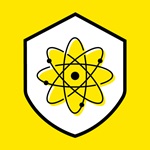
Sûreté nucléaire :
ce qu’il faut retenir
 Nuclear safety refers to all the technical and organizational measures involved in the design, construction, operation, decommissioning and dismantling of basic nuclear facilities, as well as for the transportation of radioactive substances. These are measures that aim to prevent accidents or mitigate their effects.
Nuclear safety refers to all the technical and organizational measures involved in the design, construction, operation, decommissioning and dismantling of basic nuclear facilities, as well as for the transportation of radioactive substances. These are measures that aim to prevent accidents or mitigate their effects. Nuclear safety and nuclear security, some subtle differences
Nuclear safety is all about preventing accidents and controlling the technical risks associated with the operation of nuclear facilities.
Nuclear security, on the other hand, is there to protect against malicious acts (intrusion, sabotage, cyberattacks), and covers measures to guarantee the safety and security of employees in all situations, including those related to the working environment.
Why is France a model for nuclear safety?
In France, nuclear safety is based on regulations considered to be among the strictest in the world. The operator is responsible for controlling the risks and potential adverse effects that their facility may pose to protected interests. The ASNR monitors
this control at all nuclear facilities, whether they are in operation, under construction or in decommissioning.
Did you know?
In 2025, France combined the technical expertise of the IRSN (the French Institute for Radiation Protection and Nuclear Safety) and the powers of control of the ASN (the French Nuclear Safety Authority) into a single independent authority: the ASNR (the French Nuclear Safety and Radiation Protection Authority).
This governance model reflects a desire to streamline and simplify the organization while strengthening the effectiveness of nuclear safety and radiation protection controls throughout the nuclear industry.
Global nuclear safety: a shared responsibility
Nuclear safety is a major global challenge that requires international cooperation to ensure the safety of all.
World governance to prevent nuclear risks
Since the dawn of nuclear energy, international conventions have been established to lay the foundations for a common approach to risk prevention and public protection.
International agencies such as the IAEA (International Atomic Energy Agency), which has been active since 1957, play a key role in promoting a global culture of nuclear safety.
Similarly, WANO (World Association of Nuclear Operators) facilitates the exchange of best practices among nuclear operators with the aim of continuously improving reliability and risk prevention.
In Europe: unified regulation led by Euratom
Within the European Union, nuclear safety is based on harmonized regulations led by Euratom (the European Atomic Energy Agency).
Its role is to ensure the highest safety standards across member states, while promoting cooperation and sharing
of best practices.
Each country remains responsible for its own nuclear facilities but undertakes to comply with common rules.
Worth knowing
The ALARA (As Low As Reasonably Achievable) principle consists of keeping exposure to ionizing radiation as low as possible, taking into account technical, economic, and social factors. It is applied by major regulatory bodies such as the IAEA, the ASNR, and Euratom.
Strict regulation of Orano's nuclear sites
Nuclear safety is a priority at Orano. Every year, the group conducts internal verifications on an ongoing basis, supplemented by more than 200 inspections by the ASNR and the HFDS - the French Senior Defense and Security Official [Haut Fonctionnaire de Défense et de Sécurité]. These include around 50 unannounced inspections.
How does Orano guarantee the nuclear safety of its sites on a daily basis?
Orano places nuclear safety at the heart of its commitments and implements rigorous measures to ensure the security of its facilities and the safety of its employees.The group is developing a genuine safety culture based on vigilance and risk prevention at all levels of the company.
In terms of radiation protection, the radiological impact of Orano's activities is 12,000 times lower than the regulatory limit.
The group's 2024-2026 HSE policy sets ambitious targets for strengthening nuclear and industrial safety and security.
At the same time, Orano is committed to transparency, regularly publishing reports and expert opinions on the safety of its facilities.
- Is nuclear power a green energy? Following the recent decision of the European Commission to award nuclear power and natural gas a green label, you might be asking – what is "green energy"?
- Nuclear fuel: the key takeaways Discover what nuclear fuel is made of, how it’s used and the properties it offers when generating electricity.
- Carbon neutrality by 2050: how do we get there? Understanding the principle of carbon neutrality and the actions that can contribute to it is a prerequisite for effectively acting to protect the climate by significantly limiting GHG emissions.